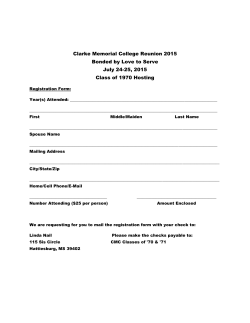
Ingrown Toenails
04/07/2015 Ben Summerhays DPM Assistant Clinical Professor Department of Orthopaedics 1 04/07/2015 1. Infected 2. Painful nail: non-infected 3. Non-permanent vs. Permanent HISTORY Duration Past treatments Frequency Medications PMH 2 04/07/2015 Physical Exam Vascular Palpation Drainage Nail borders Type of Nail Type of Treatment Slant Back Partial avulsion Total avulsion This is the partial nail Avulsion I would do if only one side is infected or if a permanent procedure is needed I would then sneak my chemical on a Q-tip under the proximal nail fold 3 04/07/2015 Partial Nail avulsion On the left just after removal, on right healed nail after avulsion Total nail avulsion-nasty nail total removal needed 4 04/07/2015 Supplies 1% lidocaine plain 5-10 ccs usually Chloraprep-usually use this Rubber band tourniquet-I only use if chemical used Curette or freer-to free nail from surrounding skin English anvil Beaver handle and blade Hemostat-straight Digital Block 5cc syringe H-block or V-block digital block 1.5 inch 27 gauge needle V block for toes 2-5 H block is for big toe 5 04/07/2015 H-block V-block 6 04/07/2015 Paint toe with betadine or chloraprep Sterile equipment Not sterile procedure English Anvil 7 04/07/2015 Beaver handle and 64 blade Nail removal-Straight hemostat Hand Rotation-rotate toward the center Residual Nail-check for after removal 8 04/07/2015 Hemostasis Release tourniquet Manual Pressure Silver nitrate Dressings Triple antibiotic ointment x1 4X4 gauze Coban Cut Band-Aid 9 04/07/2015 10 04/07/2015 11 04/07/2015 12 04/07/2015 Chemical Matrixectomy: 89% phenol chemical 10% sodium hydroxide ~90% successful Redness 2-6 weeks 13 04/07/2015 Extremely Rare to be given if nail removed Aftercare Dressing change-next morning For just infected ones abx oint, and bandaid Soaking-Warm H20 with Epsom 20 min X2-3 per day Activity-as tolerated POD #1 Pain medication-never Follow-up Global period-10 days PRN 14 04/07/2015 15
© Copyright 2025














